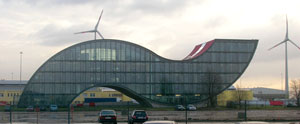Magdeburg/Sülzetal, Germany:
An Editorial Profile
An Editorial Profile
 |
| The headquarters of Enercon GmbH, a manufacturer of blades for giant wind mills (background), is shaped like its corporate logo. The nearby manufacturing complex employs about 3,000. |
Time Is Short
So how long will such an arrangement be in place in Saxany- Anhalt and the rest of eastern Germany? Not long.
"As they say in the pubs, it's last call in east Germany," says Friebe. "It's very likely that the state grants will run out by 2010."
The current scheme will be in place through 2009, after which another downgrade in investment aid will likely take effect, perhaps by 5 or 10 percent – or even elimination of such aid. "The more successful east Germany is in revamping, the less money it will get from Brussels in the future. It will become a victim of its own success, you could say."
The larger the EU grows – Romania and Bulgaria just joined – the more markets there will be to invest in with similar aid. "If one is looking to set up a large company or investment here, now is the time to do so," says Friebe. "Two years is a good time frame for a project to come to fruition. It can be done quicker, say 18 months, but the rules are strict, and you have to manage the process that much quicker."
Friebe says investors also should consider another advantage of locating in eastern Germany.
"It unifies the advantages of two worlds: the 'Old Europe' and the 'New Europe.' We have the political stability and the proven, legal systems working on a federal level," he says. "And on the other hand, we have more flexibility in terms of work shifts as well as lower wages. A three- shift schedule would not work in western Germany, but it's absolutely normal in the former GDR."
Renewable Energy Is a Good Fit
But it was the blades on the ground at their manufacturer near the Port of Magdeburg that were the problem. How to secure an inventory of hundreds of turbine blades – some as long as 39.5 meters (129 ft.) – exposed to the approaching elements as they awaited shipment to customers elsewhere? Such was the predicament of management at Enercon GmbH, a leading manufacturer of wind energy plants, employing 3,100 at a site adjacent to the Port of Magdeburg. Nevertheless, Volker Ziem, general manager of the site, took time to speak with a U.S. visitor that morning to discuss the site's strategic advantage as a supplier of large- scale renewable energy systems. (The blades were repositioned that day to minimize the gusts' impact on them, and the storm spared the facility and its assets.)
"The area was a major heavy manufacturing center prior to 1990, which meant there were many large buildings suitable for producing long and heavy material, such as what we produce," says Ziem.
|
Besides a skilled labor pool, logistics is the chief advantage of the Magdeburg location, says Ziem. "We have access to the motorways and also to the newly built harbor, where the long and very heavy blades can be transported from here." By year- end, Enercon will begin producing a new generator at the site that will weigh 200 tons.
The plant is increasing its production of wind turbine systems at a rate of 20 percent to 30 percent per year, notes Ziem, and that will be the case for the next few years. That will give the region's renewable energy industry momentum; a biodiesel refinery at the Port of Magdeburg is undergoing an expansion, and another Enercon facility in Magdeburg is just as busy as Ziem's.
Industrial growth is on the upswing in Magdeburg and eastern Germany, as the Enercon example illustrates. It will gain momentum as logistics routes and key trade markets shift east via the Elbe and into Poland and other destinations. How long industries can rely on the area remaining low- cost in terms of labor remains to be seen. And the EU subsidies won't be as lucrative in a few short years' time.


